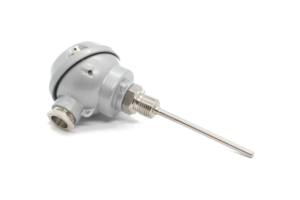1300 737 976
Call us
Live Chat
Call us
Temperature sensors are employed for a broad variety of practical purposes across many industries throughout the world. Essentially, these sensors provide input to a system in order to either approximately or accurately determine the temperature of a particular object or environment.
From food processing to medical applications, to petrochemical handling and automotive monitoring, to biological research and geological studies, to HVAC systems and other consumer electronics, temperature sensors are a crucial tool in countless fields. In fact, they’re also used throughout our own homes and offices, within the transport we travel in, and even in devices, we use every day!
What are temperature sensors used to measure?
While you may just assume that temperature sensors are simply used to find out the temperature of an object or environment, they are actually more nuanced than that. While this is one of the things they aim to measure, many temperature sensors are also used to check whether a process is taking place within a particular range. In particular, preventative reliability is a core application for temperature sensors, which help ensure a system is functioning properly, and determine whether there are impending risks of danger or malfunction.
Key types of temperature sensors
There are two primary types of temperature sensors in use today:

Common types of contact temperatures sensors include thermocouples, RTD’s, thermistors, thermostats, and semiconductor temperature sensors. They should be used when you are able to make good thermal contact between the device and what you’re measuring. It’s also easier to attain continuous monitoring and data collection with contact thermometers.
These determine temperatures from a distance, by measuring the thermal radiation emitted by an object or heat source. The applications for these are often in high temperatures or hazardous environments where you need to maintain a safe distance away from a particular body.
Thermal imaging and infrared sensors are the most common type of non-contact temperature sensors, and are used in the following circumstances: when the target object is moving (such as on a conveyor belt or within moving machinery), if it’s a great distance away if there’s a dangerous surrounding environment (such as high voltages) or at extremely high temperatures where a contact sensor would not function appropriately.
Common applications of temperature sensors
There are almost endless practical applications for temperature sensors, both for commercial and consumer needs. Here we’ve compiled a few of the most common uses for temperature sensors that you may have heard of before, or even seen in action.
Medical applications of temperature sensors are vast. The most commonly thought of use is within the thermometer, to measure the temperature of individuals in a quick and accurate manner. However, they’re actually also used for a variety of medical products including MRI imaging equipment and portable ultrasound scanners.
Within our homes, temperature sensors are used in many electrical appliances, from our refrigerators and freezers to help regulate and maintain cold temperatures as well as within stoves and ovens to ensure that they heat to the required levels for cooking, air confectioners/heaters. Even our common battery chargers use them, in order to prevent overcharging or undercharging based on measuring the battery’s temperature.
Oil mining may seem like a surprising field where temperature sensors are used, but in fact, they’re fundamental to ensure safe and effective oil mining practices. The end of oil drills has an inbuilt temperature sensor which quickly notifies the workers when it should stop drilling, since when its temperature gets too high (the further it gets through the ground without pausing), it becomes too hot and breaks.


Renewable energy sources depend on temperature sensors for the effective production of energy. From solar heating pumps to wind power turbines, to biomass combustion applications and geothermal sources, the regulation and measuring of temperatures is fundamental for these renewable sources.
Glass manufacturing relies on temperature measurement for the regulation and optimisation of their production process. Glass industry quality requirements can be highly stringent so in order to meet these, close monitoring of glass temperatures as well as the machinery being used is essential.
Chemical industries are ones that find significant practical value from implementing and using high-quality, effective temperature sensors on a daily basis. They’re required to measure extremely high temperatures to monitor chemical reactions and are used for gas chromatography as well. Sensors with a very wide temperature range and durability tend to be the ones used in this sector. In particular, high-accuracy measurement tools are needed to ensure high-quality products are created.

At Pyrosales, we are a leading manufacturer & designer provider of an extensive range of temperature sensors for all purposes, across all sectors. They’re a crucial tool required by manufacturers and industries of all types and sizes, so it’s essential to attain high-quality products to ensure your processes and practices work as expected! Contact us for more information or call 1300 737 976.
Copyright © 2022 Created by Pepper Digital
Disclaimer – Images for illustrative purposes only and may not be representative of the actual resolution of the camera shown.